Live from the day of action
Today, students, teachers, faculty, campus workers and community members are making their voices heard--in California and around the country. They're taking a stand against the ongoing attack on public education at every level, from pre-K through to colleges and universities.
SocialistWorker.org readers will contribute their reports, views, pictures and more throughout the day, and will post them here (times are all Pacific time). At 5 p.m. (PST, 8 p.m. on the East Coast and 7 p.m. in the Midwest), we'll have a live video stream from the San Francisco regional rally against the cuts.
6:10 p.m.: In San Francisco, some 20,000 people--and counting!--were pouring into the Civic Center, reported Ragina Johnson and David Russitano.
The crowd is enthusiastic and spirited. Contingents from every school in the district seems to be represented, especially from June Jordan, Balbo and Mission. Many from those high school have been marching all day.
A massive drum circle is keeping the energy up even after hours of marching. The energy is contagious.
Aaron Neimark, a Kindergarten teacher from Feinstein Elementary and part of Educators for a Democratic Union who was part of organizing an afternoon action for his school site, said, "The most powerful thing was leaving school with about 400 students and teachers for our own local march to a rally in a park in the Sunset district. We learned a lot in the process of planning since the fall. Moving forward we want to keep people informed as we continue organizing."
Martha Vigil works at Lincoln High School as security guard, and if the planned cuts go through, could lose an hour of pay every day. "The people who are making the cuts need to walk in our shoes to see what we go through every day," she said.
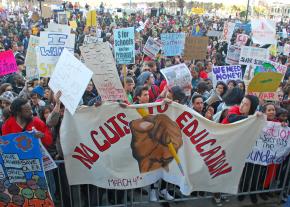
5:50 p.m.: An even larger crowd of some 6,000 people gathered in Northridge, north of Los Angeles, near the campus of Cal State Northridge, according to Rebecca, a student at LA Valley College.
With protesters on the march, police insisted that the demonstration couldn't take the streets. That prompted more than 1,000 people to walk sit down on Reseda Boulevard and refuse to leave as an act of protest.
Police in riot gear threatened the crowd, with nightsticks out. After a time, the protesters had decided to disperse, but wanted to do so in an orderly way that kept everyone together.
But that wasn't quick enough for the cops--they waded into the crowd. In the melee, an 80-year-old woman professor was injured when she was reportedly shoved by police, suffering a broken arm. Undeterred, the police started carrying out arrests.
Officers claimed they only arrested six people, but demonstrators thought the number was greater. With night falling, the demonstrators started a march to the detention center to make sure their fellow activists were freed.
5:10 p.m.: Some 4,000 people were gathered in downtown LA for the major regional rally, with more people streaming in all the time from around the area, reports Sarah Knopp, a teacher and member of United Teachers Los Angeles.
The first people on the scene were students who came from the surrounding high schools. Students at Manual Arts High School southwest of downtown walked out of classesand marched as a group of 50 or 100 to Pershing Square, the site of the rally—chanting, “Sí se puede” all the way.
University students from the surrounding area came in as well. Some 200 students at Santa Monica College rallied on their campus quad during the afternoon, and then made their way to LA.
Members of Students for Quality Education and other groups at Cal Poly Pomona gathered to board the Bronco Bus and headed into LA, 200 to 300 people strong, reported Andrea Edwards. The group’s motto is "No decisions about us without us."
According to Rebecca Sun, an Iraq war veteran spoke out from the platform, making the case that "our enemy isn't over here. It's over here. One day in Afghanistan and Iraq, we spend $400 million. That money should be used to fund education, not war."
A graduate student at Cal State Northridge and teacher's assistant in Los Angeles said that because of budget cuts, her teachers get her for only 45 minutes a day--last year, they had classroom support all day. She said that the Kindergarten classes at her school are as large as 30 students.
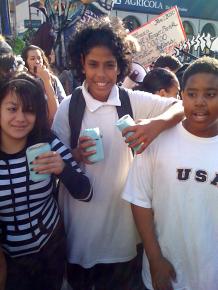
4:40 p.m.: About 7,000 students, teachers and parents from all levels of education marched down Mission Street, headed toward a giant rally at San Francisco's Civic Center, reports David Russitano, a math teacher and member of United Educators of San Francisco.
The crowd is a cross-section of all races. The feeling is festive, with costumes, homemade signs and plenty of noise-makers. It feels like the start of a massive movement.
And the crowd is still continuing to grow as schools get out!
Protesters from all parts of the Bay Area are converging on the Civic Center rally in San Francisco--expectations are high for a huge turnout.
4:30 p.m.: Teachers marched in one of two feeder marchers to San Francisco's Civic Center from northeast area schools, said teacher Robin Horne. About 150 teachers and parents from Sherman and Galileo Elementary Schools marched on Van Ness, as cable car drivers rang their bells in solidarity.
One parent said that their school had music and art programs, but only because it was funded by the PTA. The only way to get a good education is that students did it themselves, the parent explained. Dmitria said, "They shouldn't give so much money to war."
4:10 p.m.: Some 400 teachers, parents and students are posted at the busiest intersection in Castro Valley, reports John Green, a teacher at Castro Valley High School.
The car honks are deafening. This is the largest rally in Castro Valley in decades. All school sites are represented. Students are walking banners back and forth across the intersections. Not much more room left on the sidewalks, but more people keep streaming in.
Members of the California Teachers Association have been organizing at each school site, and spent the weeks leading up to March 4 reaching out to the community--inviting parent clubs, civic organizations, places of worship and other unions. That work obviously paid off with this big turnout in a Bay Area town.
3:55 p.m.: About 50 graduate students at the University of Chicago, led by their Graduate Student Union (GSU), marched from Ida Noyes Hall to the administration offices today, reported Kathryn O'Neil Weber.
They were protesting the continued difficulties imposed on them by high Advanced Residency Tuition (ART) rates, increasing costs of health insurance and activity fees, as well as the burden of being forced to teach courses rather than work on their dissertations, resulting in more years paying ART.
The students wore mouse ears and delivered mousetraps with messages pasted on them. An official report on the issue was recently dismissed with little comment by the provost of the university.
The GSU has also pitched in where the administration refuses to, paying for one student's tuition and fees for the 2010-2011 academic year with a Graduate Emergency Tuition Assistance lottery.
3:45 p.m.: Hundreds of people came out for an afternoon rally at the state capitol building in Sacramento, reports Christopher Benedict. Activists on the edge of the rally leafleted passersby and played music to draw people in. Speakers included parents, students, teachers and activists--among them representatives of faculty and students from different schools in the UC system.
3:40 p.m.: More than 300 members of the UC United Coalition of students, workers and faculty came together for a march and rally "for an accessible, diverse, and democratic University of Illinois of Urbana-Champaign." The march began at the campus' Alma Mater statue and circled the Liberal Arts and Sciences Quad before participants rallied in front of the Swanlund Administration Building.
The UC United Coalition includes the Graduate Employees' Organization (AFT/IFT Local 6300 AFL-CIO), which won its demands with a three-day strike last fall. According to the UC United statement:
State funding for public education has been decreasing for years, and the University of Illinois administration has consistently accepted budget cuts as it transforms the University into a privatized and corporatized institution...
The major burden of the lack of state funding has been placed on low-income workers and students, rather than on bloated administrative units and salaries. Speakers at the rally called for a tuition and fee freeze in the face of University of Illinois Interim President Ikenberry's recent statements that significant tuition increases, layoffs and furloughs are inevitable and necessary responses to the shortfall in Illinois state funding for the University.
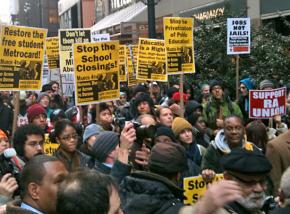
3:25 p.m.: In New York City, elementary school teacher Brian Jones called in to say that he and his coworkers were among a few hundred gathered to march and listen to speakers. Big cheers went out to any speakers who talked about taxing the rich to save and expand public education.
Protesters gathered at a rally earlier in the day at Gov. David Paterson office, reported Lyric Croy. Carl, a graduate student at CUNY and a member of the Professional Staff Congress, told the crowd, "There are larger class sizes for less pay. Students and workers are having to pay for the crisis. This will not stand."
"We see Chicago teachers standing against school closures and winning," said one speaker. "We want a better deal and have the power to do so. No to you pay. Tax the rich! Chop from top!"
As the march stepped off in the late afternoon, the crowd had grown to at least 1,000 people who headed to Fashion Institute of Technology, where Metropolitan Transportation Authority (MTA) officials were meeting.
The NYPD was forced to give up trying to confine marchers to the sidewalks, as we took the streets chanting, "Whose streets? OUR STREETS! Whose schools? OUR SCHOOLS!"
Transit workers joined marchers at the protest of the MTA meeting.
A Graduate Student Employees Union member said, "We will not stand for the budget to be balanced on the back of workers and students. We hear 'entrepreneurship,' 'privatization' and 'budget flexibility.' SUNY works because we do. We cannot have faith in the administrators to have our best interests at heart."
A banner from the Students for a Free Palestine pointed out the warped spending priorities: "Fund Schools, Don't Bomb Them."
A teacher from elementary school P.S. 30, where part of the building will be used to house a new charter school, explained, "We are an A school, by the board's standards, but they want to put in a charter school. We say yes to education and no to the annihilation of our schools!"
3:20 p.m.: A mass of anywhere from 500 to 1,000 students, faculty, workers and union members dressed in red and carrying signs left the UC Riverside campus, heading to downtown Riverside after a day of protests, reports Jennifer Ramos.
Workers who have been connected to UCR for 10 or 20 years agreed that this is the largest protest movement our campus has seen in that time.
Events at UCR got started this morning with a teach-out at the central commons area. Speakers included students, teachers, campus workers and the chancellor, Tim White.
Stephanie Hammer, a professor of comparative literature and creative writing, remarked that a highlight for her was hearing the head cook from one of the student dorms speak about the effects the furloughs have had on him being able to perform the basic and essential job of feeding students who live on campus.
The teach-in event only grew as the program rolled on, attracting scores of passersby, some of whom were compelled to miss class to join the events.
After the teach-out, the huge gathering marched to Unity Corner, a spot on the edge of campus used by students and unions for rallies and demonstrations. Students marched, chanting, "No cuts, no fees; Education should be free" as they walked off campus.
The march headed toward downtown Riverside because state legislators and one UC Regent have offices there. Before convening downtown, the march will stop twice: Once at a local community center to join with protesting members of the community who support public education, and a second time to join with protesting students from nearby Riverside Community College. We expect the rally downtown to be even larger than the rally on campus.
3:15 p.m.: More than 200 students, faculty and staff participated in a spirited march on the campus of the University of Massachusetts-Amherst, raising chants of "You got bailed out, we got sold out," and "Education under attack, what do we do, stand up fight back!" writes Michael Fiorentino.
At the end of the march route was the Whitmore administration building. Protesters entered the building, led by a team of delegates who presented a list of demands to the vice chancellor's office.
The March 4th Coalition on campus has vowed to continue the fight until its demands are met--including full funding for the University Health Services, no new fees, an end to police presence in dorm rooms and a democratic budget process.
3 p.m.: Students for a Democratic Society at University of Wisconsin-Milwaukee issued a statement condemning police brutality following an attack on a demonstration of 250 people earlier in the day that resulted in 18 arrests.
SDS was part of a campus-wide coalition called the UWM Education Rights Campiagn, which considered of dozens of organizations, including the professors' and teaching assistants' unions. The coalition organized a peaceful demonstration on March 4, with a speakout planned to bring attention to its demands.
As the SDS statement says:
The really ended in a march to Chapman Hall to deliver petition signatures to a chancellor that has thus far refused to meet with us, instead choosing to introduce us to more campus police and locked doors.
Two hundred fifty students, workers, professors, teacher assistants and concerned community members gathered today to show their support for the UWM Education Rights Campaign. SDS believes we had a great event and are proud of the students all around this country who rallied with us for education rights and stood their ground for over two hours as the police pepper sprayed, punched and arrested over 18 people.
"It is difficult to express how outraged we are of the use of police repression against a peaceful protest," commented student organizer Jacob Flom. "We are outraged by the Chancellor's unwillingness to come and meet with the peaceful assembly.
"Our thoughts and prayers go out tonight to the students who have been attacked, arrested, pepper sprayed and injured. This campaign was about the tens of thousands of youth in our impoverished city who have absolutely no hope of attending this university due to a gutless university administration and politicians who instead give billions to war, occupation and bank bail-outs."
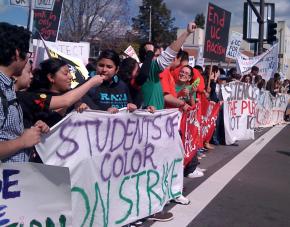
2:40 p.m.: Some 2,000 UC Berkeley students, staff and faculty participated in pickets, rallies and marches throughout the day, reports Todd Chretien--and many more discussed the budget crisis in their classes.
Starting at 7 a.m., protesters blockaded Sather Gate, the central passageway on campus. There was a heavy police presence, but activists were completely peaceful. Ominously, in the mid-morning, police arrested a campus union leader, claiming he "looked like" an anarchist they supposedly wanted. After releasing him, police continued to circulate through the crowd in an obvious effort to intimidate protesters.
A noontime rally shut down the busy street corner of Bancroft and Telegraph, and featured speeches from a campus bus driver and member of AFSCME--which recently stopped the university's efforts to privatize bus services--as well as students and staff. One student performed a spoken word piece that went in part:
It shouldn't take a typhoon for the campus to move
Lately, revolutions only seem to follow catastrophes
We only flinch when we're hit
How many lives could we have saved if we'd raised funds before the flood
Noah built an arc with his bare hands
We can take out a loan
It doesn't take divine foresight to predict the storm
We were warned before Katrina
How long until we regret California
Does the earth have to shake before we are moved?
Shortly after the rally, more than 1,500 people began a five-mile march down Telegraph Avenue to meet up with high school students from Fremont High and other schools, plus a feeder march from Laney College, for a rally in downtown Oakland, scheduled to run between 12 Noon and 3 p.m.
2:35 p.m.: Some 100 parents, teachers and students marched against Mayor Bob Duffy's bid to take full control over the city school district in Rochester, N.Y., reports Ralph Bean.
Mayoral control has already been established in Chicago, New York City and Washington D.C., among others, and has led not to improved education as promised, but to the spreading of charter schools, privatization, union-busting and tighter working conditions for teachers.
Here, mayoral control would mean dissolution of the Rochester City School Board. By denying the mostly Black Rochester population of a portion of their right to vote, many marchers feel that this is an attempt to sneak Jim Crow in through the backdoor.
The demonstration was lively. In response to the call by Students for a Democratic Society and the Community Education Task Force, marchers gathered downtown for a rally and open-mic speakout from 4:30 p.m-5:30 p.m. and then proceeded to march to City Hall with chants of "Whose schools? Our schools!" and "Don't be fooled by Duffy's lies, his plan is to privatize!"
An open town hall meeting is still ongoing to discuss next steps for the movement.
2:30 p.m.: About 500 people are picketing the quad at the University of Washington in Seattle as part of a student strike, reports Leela Yellesetty. After a spirited rally, students set up picket lines during class changes encourage students to skip class. Another short rally is planned, to be followed by a march through main classroom buildings around the quad.
All the campus unions endorsed the action, including the Washington Federation of State Employees, the Service Employees International Union and the graduate students represented by the United Auto Workers. Some high school students and community college students came to campus to join the protest, though another action was planned at Seattle Central Community College.
The most popular chants are, "This what democracy looks like," "Whose university, our university" and "Hey, hey, ho, ho budget cuts have to go."
The University of Washington Student-Worker Coalition is making several demands, including: a freeze on tuition; the replacement of loans with grants; a democratic budget allocation; chop-from-the top cuts to administration, including a cap on all salaries at 150,000 per year; an end to layoffs and speedups for workers and accessible public education for all.
At one point, a chant went up "They say fee hikes, we say strike." At this point, the growing protest took off from campus, taking over the main street University Way.
2:10 p.m.: Around 200 rallied at the University of Minnesota today to stand up to massive tuition increases and staff furloughs, wrote Chance Lunning.
The rally, organized by students and union members, called on university administration to "chop from the top" instead of passing the burden of the budget crisis on to students, faculty and staff.
Some 250 administrators currently make over $200,000 a year. According to the Minnesota Daily, U of M basketball coach Tubby Smith, pulls in actual total earnings in excess of $1.7 million.
1:55 p.m.: At Portland State University in Portland, Oregon, 300 students, alumni, and faculty gathered for a rally at 1 p.m. followed by a march around the campus.
Students, faculty and members of community organizations offered inspiring speeches, and frequent updates of actions in solidarity around the country were followed by long applause. Live music spurred an impromptu dance party in front of the stage for future PSU students--over a dozen preschoolers from the university's child care center who joined the rally with childcare staff.
"Many of you know about the structural adjustment programs that have devastated developing countries," one PSU faculty member said. "Well, college debt is a deliberate structural adjustment on our own citizens. Economic democracy is a key piece of real democracy. And we don't have it. Yet!"
At the high point of the rally, protesters began a march that went through three major campus buildings and ended up at the office of the president. There, protesters raised their demands, including opposition to cuts in Black, women's and ethnic studies programs.
A number of students talked about the threat posed here by the Frohnmayer report--a study named after its author, retired University of Oregon President Dave Frohnmayer, that outlines a plan to restructure the public universities as public-private corporations. The consequences of such a move are clear: corporate management, tuition increases, lack of student voice and restriction on faculty curriculum, to name a few.
PSU student Adam Sanchez spoke at the rally. Here are some of his remarks:
Budget cuts have already cost over 40,000 teacher jobs in the course of the recession. Because tax revenues have declined as a result of the recession, 27 states and the District of Columbia have made cuts to K-12 education and 36 states have made cuts to higher education.
These cuts are not accidents. They are part of a conscious strategy by those with wealth and power to make working people and students pay for the economic crisis...
The government has prioritized bankers' bonuses over teachers' jobs. And we all know that when a school loses teachers, class sizes go up, and education gets worse. The sad fact that many people today are realizing is that our government, whether controlled by Republicans or Democrats, puts the interests of bankers and employers before the interests of students and working people.
The government's priorities are exacerbating the budget crises nationwide and the crisis in public education. In Oregon, we recently voted in Measure 66 and 67, which send a very different message about what our priorities are. We said that we want to tax the rich and wealthy corporations to pay for teachers' jobs and quality public education.
But let's be clear: These measures were far from an adequate response to Oregon's crisis. The money these measures raised is less than one-sixth of Oregon's $4.4 billion budget hole, which is only expected to get worse.
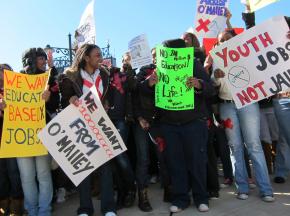
1:45 p.m.: Some 500 Baltimore-area high school students and supporters took to the streets this morning to demand an end to what they call the "schools-to-prison pipeline," Ben Dalbey writes.
Students are outraged that after cutting $30 million from Baltimore city schools, Maryland Gov. Martin O'Malley plans to spend $300 million to build three youth jails in the city.
The Baltimore Algebra Project is demanding $100 million of that money be spent instead on youth jobs and education programs. Protestors marched through downtown chanting, "No Education, No Life!" and "We don't want your pity, we want funding for our city!" The march ended with a protest at the downtown juvenile justice center, also known as "Baby Booking," to call attention to the fact that while last year, 4,285 Baltimore youth graduated from city high schools, some 5,876 were locked up.
1:40 p.m.: Two hundred Cañada College students walked out of class this morning and gathered in the campus quad for a speak-out against budget cuts, reports Elizabeth Terzakis.
The college's budget was cut by 10 percent in the last year, leading to the cancellation of more than 27 sections (out of a total of about 600) this semester, and reducing student services programs that help first generation, disadvantaged and disabled students to access their right to education. Both counseling hours and book vouchers were cut in half, while disability testing was moved off campus.
Cañada is facing a second 10 percent cut to its budget in the next year, which will result in the cancellation of over 100 sections next semester. The English as a Second Language Program will be hit particularly hard; almost all the part-time faculty in the department did not get assigned any classes next semester.
Since Cañada has historically served Redwood City and East Palo Alto's large immigrant communities, these cuts are likely to have a significant impact on the racial composition of the student population.
The walkout was called by Cañada Strikes Back! (CSB), a student group that also organized a teach-in earlier in the semester. CSB co-founder Katy Rose challenged campus administrators to take responsibility for the cuts or join in the fight against them:
The administrators say their hands are tied. Well, I got up the other morning, and the content of my bank account was negative $1.75. My net worth was less than a half a tank of gas. But I'm still here. Because if there's one thing working class people are good at, it's finding a way out of no way. And that's what we need from our administration. No more cuts. No more excuses. The money is out there. It's their job to find it.
After the speak-out, students presented a list of demands, signed by all present, to the college president, and then marched to the campus entrance, which was being picketed by Carpenters Union Local 217. The carpenters were out because the San Mateo Community College District has hired nonunion carpenters to do the finishing work on a faculty housing complex that is being built on Cañada's campus. Students stood beside picketing carpenters and chanted their support while calling for solidarity between students and workers.
After marching back to the center of campus, students formed carpools to join in the march and rally for public education in San Francisco.
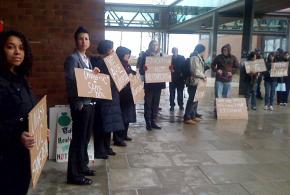
1:30 p.m.: Despite the snow, about 100 students, faculty and staff took part in an outdoor rally and speak-out at noon at UMass Boston, reported Julie Keefe.
Speakers voiced anger at student fee increases--a $1,500 fee increase was passed last year--and budget cuts to education--Massachusetts decreased funding to higher education by 37 percent between 2008 and 2010.
One speaker questioned the priorities of UMass, which granted President Jack Wilson a $73,000 raise this year. Meanwhile, UMass teachers are asked to do more and more work for less pay. And every student knows several others who couldn't return to campus this semester due to costs.
For 40 percent of Massachusetts families, the cost of one year at a four-year public university is equal to more the 50 percent of yearly family income. It's no wonder that over one-third of UMass Boston students report stress due to lack of money for personal and family essentials, such as food and rent.
We chanted "Education is a right, not just for the rich and white!" After hearing several speakers, the speak-out transformed into an impromptu march through campus. We were able to march through each building on campus before police blocked the entrance to the Campus Center and threatened arrest.
Popular chants were "Real pain, real action!" in solidarity with the anti-racist struggle at UCSD and "What's disgusting? Union busting! What's outrageous? Tuition raises!"
The next step is a teach-in about the budget cuts, with students, faculty and staff speakers. It's at 4 p.m. today.
1:15 p.m.: About 50 students walked out of classes at the University of Maryland-College Park to protest a modest tuition increase and the use of tuition dollars for development projects and administrator salaries, instead of improved instruction, writes Brian Tierney.
Students assembled near the student union building and then marched to an academic building where teach-ins are being held on topics such as hip-hop and education, the corporate university, and race and gender in the classroom. A general assembly is planned later in the day to discuss the state of education at UMD.
The pending 3 percent tuition increase at UMD pales in comparison to the massive hikes and budget cuts on the West Coast, sportswriter and activist Dave Zirin pointed out in explaining the lower turnout than expected for the UMD actions. Zirin joined UMD student organizer Suzaana Elizabeth Rose on campus for the mid-day actions and gave a teach-in on sports and education.
The Washington Post quoted Bob Hayes, another student organizer, who explained why they organized the actions today. "We feel disconnected from our education," Hayes said. "We're being run by a Fortune 500 company instead of by a university."
Meanwhile, although no protests for education are taking place in Washington D.C. today, this evening an activist panel event, "Defend Public Education" will be held in the city. The panel will feature student activists from the University of the District of Columbia and UMD. A teacher from nearby Prince George's County, Maryland school district--which just announced massive budget cuts, layoffs and furlough days--will also speak on the panel, in addition to a Washington, D.C. public schools parent and board member of Empower D.C., a local economic justice activist organization.
1 p.m.: About 100 students and activists gathered for a rally and speakout at City College of New York in Harlem, reports Lyric Croy. The protest against the harsh cuts being carried out by the state government lasted for several hours.
"Nothing's going to change if we don't get mad and do something about it," a speaker from the CCNY Black Student Union told the crowd. "We made this school, and we have the power to change it."
Emotions ran high for CCNY students because many who are now going to City College recently graduated from a New York City high school that has been shut down under the rule of Mayor Michael Bloomberg and Schools Chancellor Joel Klein.
The cuts are following students into the city college system. Hector Agredano said that grad students are being required to teach three classes each semester, and they are paid only $20,000 a year--far cheaper than it would cost to pay someone with full benefits to teach.
12:55 p.m.: In Austin, Texas, around 200 people came out for a demonstration on the University of Texas (UT) campus against budget cuts and for public education. After hearing several speakers, the protesters marched to the famous UT Tower, chanting: "Take the power out of the tower."
Matt Beamesderfer was one of the speakers at the rally. Here's part of what he had to say:
Today, hundreds of thousands of students are protesting around the U.S. The problem: higher education run for profit, not for the ones who need the education. What that means is higher tuition in a tough economy, less of the classes available for a well-rounded education, and a generation of people with a permanent debt.
This affects me personally since I'm in school full-time with two jobs. I was reading an article the other day in which a student had to decide whether or not to buy books or eat. This is the picture of what is going on.
The problem is that this isn't unique to higher education. Same when it comes to health care. Same when it comes to Social Security. Same when it comes to the wars being conducted in Iraq and Afghanistan. This is a systemic problem that won't change on its own.
The fact is that Texas has money. Think of the new Liberal Arts building being built as I speak. Think of the insane raise that Mack Brown, the UT football coach, was given recently. I don't know if you guys saw that last game--he lost. The real problem is those resources are used to help the rich and begrudgingly doled out to the poor.
12:50 p.m.: At the University of California Los Angeles at 12 p.m., the protest was growing, as at least 1,000 people gathered in Bruin Plaza, reported Cindy Kaffen. AFSCME Local 3299, which represents general services workers and patient care workers at the medical center, led the protest.
Jose Mendez, who has worked at UCLA for 26 years, said that he can't afford to send his kids to UCLA, and neither can other workers he knows. "Students and workers have to fight together against tuition hikes," Mendez said. "We have to fight for the kids in the future who won't be able to afford to take classes here."
He added, "We've always come out for student, and the students come out for us . We have to be united against the regents, because they're the ones cutting things for all of us."
Later today at 4 p.m., teachers who are members of the United Teachers Los Angeles other unions will rally with their students downtown.
A protester named Roslyn explained that her entire education is the product of California's public schools. She went to LA city schools, then a city college, then she transferred to a UC school before going to Cal State for graduate school.
Asked why protesting was so important, she said, "Whenever a group shows solidarity and takes a stands, it helps shift perception. People have no idea what the budget cuts really mean, and today's actions will help show the real costs and hopefully force a change."
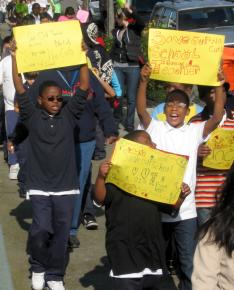
12:45 p.m.: Oakland High School students and teachers joined the picket lines at 7:30 a.m., reports Todd Chretien. Some 25 teachers and staff joined about 50 students and parents on an informational picket line this morning starting at 7:30 a.m. Teamsters in Waste Management garbage trucks, blasted their horns to show support, as did bus drivers for AC Transit, members of the Amalgamated Transit Union. Commuters honked for solidarity, too.
Oakland High teacher and Oakland Education Association (OEA) site rep Jessie Muldoon explained why she and her coworkers are on the street today. "We're out here to protest the draconian cuts to education. And we're out here as teachers fighting for a good contract in the midst of a recession because we believe that good teachers are the heart of a good school."
Students boiled down the issue to its core. "I want the law makers to stop giving the money to the prisons and start giving it to schools because education is the future," said Lisa Lac, a 16-year-old junior.
Tina Brown, 16-year-old sophomore, agreed. "I'm out here today so they know to stop taking the money. Our school needs clean bathrooms and supplies for school. Our parents and teachers are out here so that we can have a future."
Her classmate, 16-year-old sophomore Cornneisha Godfrey, agreed. "The law makers need to fund more programs to keep kids in schools and out of the streets and in jails. I love everything about school and I'm really happy to hear all the people who are beeping their horns for us... especially the big ol' trucks!"
Ben Visnick, Oakland teacher for 30 years, a candidate for Oakland School Board, gave the picture for the protest:
We're out here fighting the cuts from higher education to K-12. It's gotten a lot worse over time. We had many more electives at Oakland High in the past, many more career and vocational education programs. It's been a war of attrition against public education. We are so far behind. If you compare teachers to other employees with similar responsibilities, like helping-professionals, nurses, firefighters, etc. They often begin at $70,000 per year, we begin at $39,000. We have to start fighting back like never before if we're going to get parity with our peers.
After spending the first hour of school making signs to express their opinions, teachers and staff at the Manzanita Seed and Manzanita Community elementary schools led 500 students in a march around the block, Todd Chretien reports. Neighbors waved and drivers honked to show their support.

One teacher explained to the kids, "This is what democracy is all about. You have to think about what you want and what your community needs and then you need to speak up for yourself. Today we've learned a little bit about how to do that." There were smiles all around as dozens of parents joined in to let their voices be heard and kids led bilingual chants. "¡Vivan las escuelas!" was one popular grito, while 7-year-old Isabela got her classmates yelling, "Schools need money too!"
On my way to UC Berkeley for the noontime rally, news helicopters hovered overhead filming the protests and TV satellite trucks were following school marches. There I found a spirited protest at Sequoia Middle School students and teachers at the intersection of Fruitvale and MacArthur Blvd.
Just 10 blocks away, I ran into a march by Allendale Elementary students, parents, teachers and staff and caught up with Betty Olsen-Jones, president of the Oakland Education Association for quick interview on the fly:
We're out here today to oppose these terrible cuts at all levels of public education. It's so wonderful to see students from kindergarten to seniors in high school out on the streets with their parents, teachers and support staff. And this day of action shows that we can unite with all the other levels of public education--from the community colleges to the California State University system to the University of California--so that they can't pit us against each other.
For teachers in Oakland, today is just a starting point, because we've called for a March 24 one-day strike to try to get a decent contract. We're opposing the district trying to increase our health care costs, and we've got to fight to keep our class sizes small so our students can get the education they deserve. And we've got to find a way to get a raise for our teachers. We're the worst paid teachers in the seventeen surrounding communities and that makes it very hard to recruit and keep good teachers.

12 p.m.: Recent racist incidents--including a noose that was found in a campus library and a racist "Compton Cookout" organized by a campus fraternity--at the University of California San Diego (UCSD) have sparked outrage and protests over the last few weeks by hundreds of African American students.
Last week, students furious at the administration's foot-dragging organized a 150-person-strong occupation of the chancellor's office, with some 500-600 protesters protesting outside throughout the day.
At UC Berkeley, about 200 anti-racists organized a protest in solidarity with African American students at UCSD on Monday, gathering at the main gate to campus, wearing black clothing.
The recent anti-racist struggles show that students are fed up and ready to take on the bigots. It also highlights the important link between the struggles for diversity on campus and against the budget cuts that making it harder for Black and Latino students to attend college.
11:45 a.m.: Powerful speeches indicting California's upside-down priorities will be heard up and down the state today. But one voice, sadly, is silent: the late Peter Camejo, the longtime Green Party candidate, activist and socialist. In his three campaigns to be governor of California, Peter put the heat on the wealthy and corporations pay their fair share of taxes to repair public education and restore social services. In his 2006 book, California Under Corporate Rule, Peter wrote:
How could it be that California could afford free higher education 45 years ago, when there was less money per person and far lower productivity? What happened? Just from the years 1970 to 2001 the American economy more than doubled, adjusted for inflation. During the economic rise of the late 1990s California's foreign exports tripled in a 10-year period. Why can't we continue to finance public education?
The answer, not surprisingly, is a regressive tax system that forces workers to pay a far higher share of their income in taxes than the wealthy, once sales taxes, tolls and other indirect taxes are factored in. To illustrate the point, he looked at a sample of exactly typical 100 adult Californians:
The top 1 percent of our people--that is just one of our hundred in this example--has more income than over 60 percent of our people. The top 5 percent make the equivalent of 85 percent of the income earned by the other 95 percent of the population. If that top 5 percent is not paying its fair share of taxes, it is impossible to balance the budget. If there is one fact that explains the budget crises and decline of funding for education in California, it is this fact. This is the policy promoted by the Democratic and Republic parties, which have consciously and deliberately raised your taxes and allowed education to decline as they cut the taxes of the rich and of corporations.
Peter would have been an enthusiastic builder of today's protests. He will be missed--but his many contributions to this struggle will endure.
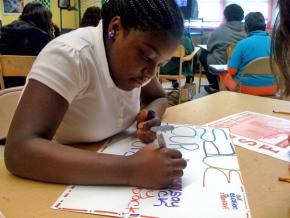
11:30 a.m.: At a school in the Bernal Heights neighborhood of San Francisco, students are getting ready to take part in the demonstration later in the day, reports David Russitano, a teacher and member of United Educators of San Francisco.
During a planned disaster drill earlier in the day, the whole school chanted, "They say cut back, we say fight back!" Students then started writing letters to the governor and making signs. Many signs say "Save our future" and "save our education."
There will be a campus speakout later today--more updates soon!
11 a.m.: On the other side of the country from California, students at Hunter College in New York City are rallying and walking out of classes to protest budget cuts carried out by their own state and city governments.
Around 100 students gathered inside the Hunter building for a rally and then attempted to march up the building's stairs to call on other students to join a walkout--but police prevented students from going up the stairs. There's a heavy police presence on campus, and a few minor confrontations broke out between police and protesters.
After about a half an hours, some 300 to 400 students marched outside Hunter and gathered for a rally and speakout. There's a clear sense of outrage among students, and the energy at the rally is very high, with organizers expecting the crowd will continue to grow. Speakers emphasized the need to build a national movement to fight back against the onslaught of budget cuts and privatization--a movement that brings students, workers and teachers together in a national struggle for public education.
Hunter students are preparing to march to Gov. David Paterson's office for a citywide rally later in the day.
10:45 a.m.: At SF State, some 300 faculty and students were protesting at 19th and Holloway, as the California Faculty Association began its picket, joining students who were also there.
Several faculty members canceled their classes and invited students to join the picket line. As the picket line grew, a favorite chant of "Whose university? Our university!" rang out, reported Alex Schmaus. Passersby honked in support.
"This isn't just about the tuition and fee hikes for students," said SF State student and member of Students Faculty Staff United Cole Sanchez. " This is about protesting the larger cuts to social services. The politicians are trying to pit different sectors against one another--funding for education instead of health care, for instance.
"But it's really a crisis of priority. Corporations are making record profits this year, but they're putting the burden on our shoulders. That's what we're fighting against."
About 200 protesters marched around campus and then to Malcolm X Plaza, where some 800 people rallied.
10:20 a.m.: In Oakland, about 100 students and teachers rallied before school at Oakland High School, reports Oakland Education Association member Jessie Muldoon. The rally was met with honks and support from parents dropping their kids off, and grew in size as students arrived for school.
This was only the beginning of a day actions across the district. Later in the morning, public schools across the state held mock disaster drills to draw attention to the disaster that's currently facing public education. Some schools organized rallies and teach-ins, some are marching, and some are walking out.
Due to safety concerns because of major construction at Oakland High School, teachers held disaster drills in their classrooms, followed by classroom discussions on the crisis. Here, we reprint an excerpt from a statement, written by Oakland Education Association member and special education teacher Payton Carter, which was read over the intercom:
The recent earthquakes in Haiti and Chile remind us of the potential devastation that could happen if an earthquake strikes again in Oakland, and the dangers of living close to active fault lines...However, we are taking this time to address another statewide disaster that is destroying our public school system, slowly crumbling the walls of our once exemplary institutions, and shaking the very foundations of our society.
Today, every school in the state is holding a mock fire drill to protest the cuts to education at all levels. This simultaneous fire drill symbolizes the state of emergency currently affecting public education.
Oakland High School is facing $1.1 million in cuts, which will affect staffing in all areas of the school. We will potentially have bigger class sizes, less security, secretaries and custodians. Students and staff protested before school today, holding picket signs and passing out flyers.
If anybody listening would like to participate in large-scale protest actions after the school day, you are encouraged to join thousands of other students, parents and teachers in attending the Oakland Education Association sponsored rally at Frank Ogawa Plaza in downtown Oakland which will run from 12-4 p.m., march en masse to the state building, and then BART to the Civic Center in San Francisco for a massive regional rally and protest starting at 5 p.m.
Every school in the state of California is holding disaster drills as I speak, but elementary, middle and high school students are not the only ones affected. Every CSU and UC in the state is also holding huge rallies to protest the cuts and tuition hikes on their campuses....
On September 24, 2009, a student strike at UC Berkeley planted the seeds of this now nationwide action. Students tired of cuts and tuition increases felt it was time to demand that California fulfill Article 9 of its constitution, which declares that public education is a fundamental right of its residents.
This means increased funding! It is time for corporations and wealthy Californians to pay their fair share! It's time for all of us to get involved and fight for what is every Californian's right. This is not just about your future; it is about all of our future.

10:10 a.m.: Every state in the U.S. is struggling to balance its budget--and according to the National Governors Association, the worst is yet to come.
That's the excuse that Gov. Arnold Schwarzenegger, state lawmakers and school officials use to justify their cutbacks, fee hikes at the universities, layoffs and demands for concessions from union workers--there just isn't any money for our schools.
But a graphical feature by Eric Ruder in the current paper edition of Socialist Worker makes it abundantly clear that the money could be found for public education if the politicians wanted to act.
Ruder points out that cuts from last year's budget in California, agreed to in a deal between Schwarzenegger and Democratic leaders of the state legislature, totaled a little over $15 billion. But that pales in comparison to the income last year of the richest 50,000 Californians--a total of $175 billion.
These super-rich residents of the state paid $17 billion in state taxes (income, sales and other taxes combined)--that is, less than 10 percent of their income. In other words, a one-year tax hike on 50,000 of the super-rich would close the California budget gap in one fell swoop.
Overall, the estimated total budget deficit for all 50 states in 2010 is $180 billion. Cutting the U.S. military budget by less than 10 percent would cover the entire budget gap, saving funding for schools, social programs and more. Just the annual spending on the U.S. occupations of Iraq and Afghanistan would nearly amount to the total deficits.
That's the reality of the misplaced priorities of U.S. political leaders. The money is there to save our schools--if the politicians would tax the rich and end U.S. wars halfway around the world.
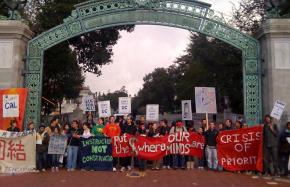
9:35 a.m.: Picket lines have been up at the entrances to UC Berkeley since early morning.
Last September, more than 4,000 students, faculty and campus staff took part in protests and walkouts against the budget cuts in the first big day of action in California. The movement spread with occupations and other actions on campus. And Berkeley was host to the October 24 conference that made the call for a day of action on March 4.
Ahead today at Berkeley are a Noon rally at the entrance to Sproul Plaza, followed by march starting at 1 p.m. from the Berkeley campus to Oakland's Ogawa Plaza, where students, faculty, staff and the campus community will participate in the East Bay regional rally--and then the San Francisco protest starting at 5 p.m.
9:10 a.m.: At San Francisco State, Alex Schmaus reported that the day of action was just beginning, with some 40 people protesting at the school entrance. They held a banner with a slogan that matches the mood of many campus activists: "SF State United--Shut It Down like '68." Students were awaiting the faculty association pickets that will begin at 10 a.m.
The Ethnic Studies Building has already been shut down, and MEChA students marched in front of the building.
9:05 a.m.: Activists fighting to defend public education in the U.S. are getting solidarity from around the world.
Democracy Now! reports that the Congress of South African Students called on students to boycott classes at nine campuses. A protest in in Johannesburg calling on the government to provide free education for the poor was attacked by police, who used water cannons to disperse demonstrators.
A group of students and professors at Moscow State University sent the following statement of support to the demonstrators in California:
We support your struggle against privatization of education, cuts, fee hikes and layoffs. Each person should have access to quality education. State money should go not on war or indemnification of the losses of big banks and corporations, but on development of human potential.
Besides, we are revolted by repressive actions of administration of University of Berkeley and police against the well-founded protest of citizens. We consider protests of students, teachers and educators to be legal, and attempts by authorities to prevent those activities inadmissible.
We express you our solidarity and we wish you success in your fair demands.

8:40 a.m.: The UC Santa Cruz campus has been shut down, reports Rachel Cohen. Pickets started at 5 a.m., with around 300 people showing up at both of the main entrances to campus. Right now, there are around 500 people on the blockade, and the numbers are growing.
Most of the staff on campus has been given the day off. When campus members who are members of AFSCME got clearance to have the day off, many came back to join the picket line. They and some faculty members have joined students at the entrance to the campuses.
For the first half hour, the administration was letting emergency vehicles go through the picket lines at the campus entrances. The purpose of this was to allow other cars following the emergency vehicles to slip onto campus. When picketers refused to allow this to go on, two of the cars rushed the picket line, and one protester was struck by a car, suffering a minor injury.
The administration tried about a half dozen times to gather up dining hall workers and slip them onto campus in vans. So students and activists organized mobile picket lines--they think have so far been successful in turning away the vans.
UC Santa Cruz students and activists are looking forward to two rallies during the morning, and a General Assembly meeting at the end of the day to discuss the way forward.

7:30 a.m.: A day of strikes and actions is getting underway across California and around the U.S.
The California protests have been building since last September, on one of the first days of school for UC campuses, when students organized for demonstrations to coincide with a one-day strike by a union for campus workers, the University Professional and Technical Employees.
The success of rallies and walkouts that day led to an October conference in Berkeley, Calif., attended by 800 students, teachers and education workers, representing every level of the public system, grade school through to the colleges. The Berekely conference set March 4 as a statewide day of action.
The protests continued to build in the meanwhile. Beginning with September, student activists began to carry out a series of building occupations. That development hit a high point in November with a coordinated series of actions across the state when the UC Board of Regents were meeting at UCLA to consider--and ultimately pass--a proposal to increase fees (the equivalent of tuition in the UC system) by 32 percent next fall.
According to a list compiled by members of the follow-up committee for the October 24th conference, there are seven regional rallies across the state and nearly 50 universities, colleges, high schools and school districts where events of all kinds--rallies, protests, walkouts and job actions--are taking place throughout the day. And March 4 has been taken up in other states by activists and unions fighting their own budget battles.
SocialistWorker.org has asked its readers in California and elsewhere to send us reports, opinions, stories and photos. We'll publish them here throughout the day. Probably, those reports won't start flowing in for some time, but we'll get them to you as soon as we can. And if you're like us, you're looking forward to a day when our side can raise its voice against the cuts and the conditions that are making working people's lives harder and harder. Enough is enough!


